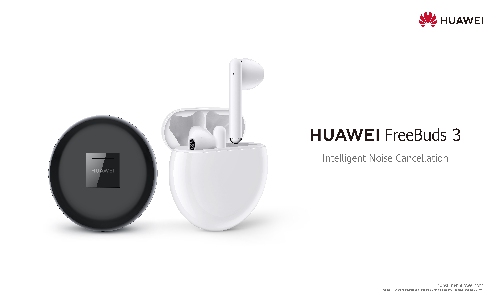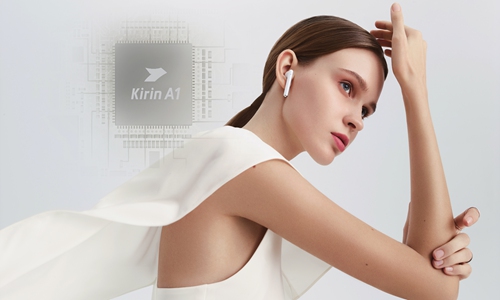HOME >> SOURCE
Discover how Huawei made its FreeBuds 3 wireless earbuds
Source:Global Times Published: 2019/12/30 17:11:46
The world’s first open-fit active noise cancellation TWS earbuds

Photo: Courtesy of Huawei
With the rapid development of 5G and AI technologies, the era of the IoT (Internet of Things) is accelerating. According to the Huawei GCI Report 2025, the number of digital devices per capita in the world will increase to 25 within the next five years. That type of rapid growth begs the question: how will consumers make natural and smooth interactions with the increasing number of digital devices? The answer lies naturally in instant automatic speech recognition.
As the most convenient and private touch point of interactive voice response, headphones will become an indispensable part of consumers' lives. Stable connection and seamless switching between multiple devices, as well as high-quality audio has become an inevitable trend in the development of the wireless audio industry.
Due to increasing user demand for high-end audio products in the era of full-scenario AI life, Huawei has released the FreeBuds 3, its flagship TWS (True Wireless Stereo) earbuds powered by its first self-developed wearable chip Kirin A1 at IFA2019.
The Kirin A1 supports both TWS headsets and wearables with Lite OS to solve the industry's pain points on chips and end-to-end systems while providing consumers with a high-end audio experience across all scenarios.
Kirin A1 chipset
The Kirin A1 chip is the industry's first BT/BLE dual-mode chip to be certified by the Bluetooth 5.1 standard. It has a highly integrated 3+1 modular architecture: advanced Bluetooth processing unit, powerful audio processing unit, an ultra-low power consumption app processor and a separate power management unit, ensuring an efficient and stable connection.
Huawei's self-developed dual-channel synchronous transmission technology can make the left and right earphones directly receive signals from the mobile phone, avoiding the interference between the two headphones.
Thanks to this technology, the HUAWEI FreeBuds 3 earbuds can significantly reduce audio latency during gaming to 190ms (data from Huawei Labs), synchronizing the game.
Based on Huawei's new generation Bluetooth channel selection algorithm, taken from the intelligent frequency hopping technology in the communication field, HUAWEI FreeBuds 3 can dynamically identify the frequency band affected by Wi-Fi and hop to an undisturbed channel, quickly adapting to environmental changes, to achieve higher anti-interference ability and bring a smooth audio experience even in environments such as airports and shopping malls.
At the same time, the Kirin A1 has a powerful audio processing DSP that supports real-time recognition of noise and ambient sound, creating a high-quality phone call and music experience.
Through the accurate 3A noise reduction algorithm, it can effectively weaken the ambient noise and let people hear more clearly. The enhanced speech recognition algorithm allows users to activate the device with their own voice, easily access the AI assistant and achieve fingerless operation.
LiteOS adds intelligence
An operating system plays a critical role in making IoT-based devices smart. Huawei LiteOS, developed in 2012, is an IoT-oriented software platform integrating an IoT operating system and middleware. Since its release in 2015, Huawei LiteOS has been widely used in various domains such as Huawei smartphones, personal wearable devices, Smart Home scenarios, urban public services, and more.
LiteOS is a platform that connects IoT hardware and service applications. It is adaptable to mainstream chips and modules, helping to maximize performance.
It can abstract functions of hardware and generate standard interfaces with a wealth of capabilities (such as device-cloud interconnection, low power consumption, sensors, and AI).
In addition, it supports a wide range of business scenarios and provides various technical frameworks and SDKs. The HUAWEI Freebuds 3 is equipped with LiteOS, which enables faster connection between multiple Huawei devices.

Photo: Courtesy of Huawei
Open-fit TWS earbuds
The HUAWEI FreeBuds 3 are the first audio flagship product to feature Huawei's proprietary chip, Kirin A1. Instead of merely inheriting the concepts of true wireless, freedom from the first two generations of products, the HUAWEI FreeBuds 3 come with genuine new innovations and technologies developed by Huawei, offering powerful performance for the best audio experience.
HUAWEI FreeBuds 3 features Kirin A1 which has an efficient chip architecture and dual channel synchronous transmission technology to provide an overall enhanced experience, including better anti-interference, lower latency while in game, more stable connection and smooth and stable call experience anytime, anywhere.
Huawei designed the noise-cancelling technology based on a user's behavior in different scenarios, including active noise-cancelling in an open-fit earphone design allowing users to enjoy a clear and comfortable music experience, even in a noisy environment.
HUAWEI FreeBuds 3 has a unique open-fit design, allowing users to have a comfortable and carefree wearing experience, suitable for multiple scenarios. HUAWEI FreeBuds 3 are the world's first open-fit active noise cancelling Bluetooth earphones that are comfortable to wear.
Connecting the future
These innovations make the HUAWEI Freebuds 3 one of the most compelling earphone propositions on the market today and certainly the world's first true wireless stereo earphone with ANC in an open-fit design.
The open-design element is important as many users report a preference for this style when using earphones for a prolonged period of time. Audio technology has come a long way in a relatively short space of time. The pace of innovation is unlikely to slow down given consumer appetite for new ways to enjoy content on the move.
The HUAWEI Freebuds 3 are the pinnacle of Huawei's audio technology and its flagship audio product. With a stated mission to dream of the impossible and then create it, Huawei will continue to play a leadership role in this sector, helping consumers to work smarter and enjoy their leisure time with more immersive and seamless experiences.
Technological innovations like ANC play an important role in this vision, helping to protect hearing, improve voice calls for mobile working and deliver better audio experiences.
The full-scenario AI life strategy of Huawei's consumer business has also taken on the vision of "connection."
Huawei's carrier business is responsible for the connection of the main pipeline through the optical fiber, 5G and millimeter wave, and the consumer business offers connection to every corner of the user's life through a variety of terminal products.
Guided by the full-scenario AI life strategy, Huawei's consumer business has integrated chip, OS and terminal products end-to-end through continuous technological innovation, creating a 24 hour high-quality audio experience for consumers.
Posted in: PRESS RELEASE